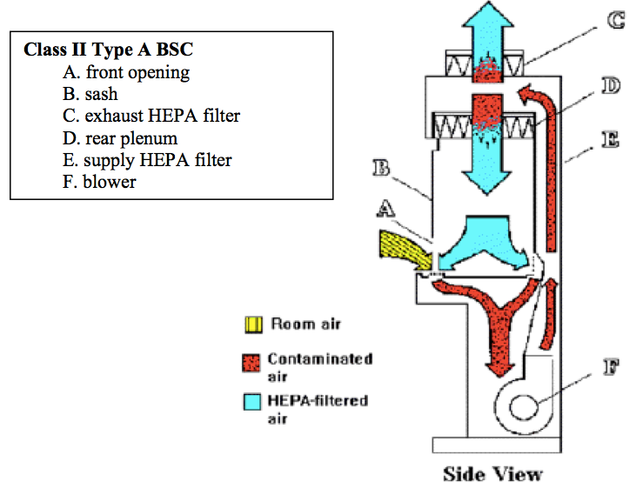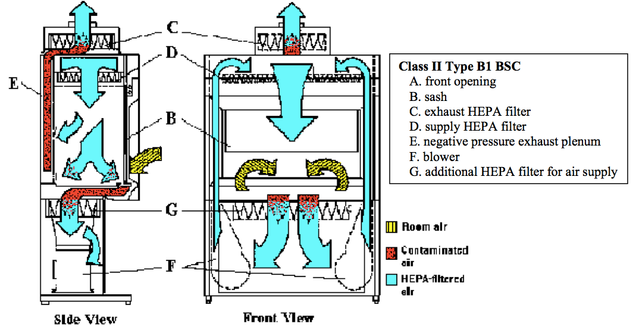Appendix B: Laboratory Ventilation and Containment for Biosafety
Laboratory-ventilated containment equipment fall into three (3) major categories:
Laboratory Chemical (Fume) Hoods
Traditional laboratory chemical (or fume) hoods are designed to capture and control chemical vapors and pull them away from the worker. Although the inward flow of air protects the user, chemical hoods do not protect the product (the desired organism being manipulated).
Other Local Exhaust Ventilation (LEV) Systems
Horizontal Laminar Flow Clean Bench
With horizontal laminar flow clean benches, HEPA-filtered air flows horizontally across the workspace directly toward the user. These clean benches provide product protection and were originally designed to provide a particulate-free environment for the manufacture of semiconductor components.
Clean benches provide product protection against microbial contamination, but they do not provide personal or environmental protection. In fact, the horizontal flow of air will blow biological agents directly toward the user and into the laboratory. Clean benches are not a biological safety cabinet, and they should not be used with any materials (biological, chemical, or radiological) requiring containment for protection of personnel or the environment.
Clean benches are acceptable for use with materials that do not present risks to the laboratory workers (including immunocompromised individuals who may frequent the lab). Human cell lines and nonhuman primate cell lines are generally considered to be BSL2 agents and would not be suitable for use in a clean bench.
Biological Safety Cabinets
Biological safety cabinets (BSCs) are divided into Class I, II, and III (see schematic below). Class II BSCs are subdivided into type A and type B. All BSCs provide personnel and environmental protection, with Class II BSCs also providing product protection.
- Personnel protection is achieved by inward airflow through the front of the cabinet.
- Product protection is achieved by downward HEPA-filtered airflow from the top of the cabinet.
- Environmental protection is achieved by HEPA filtration of exhaust air.
| New NSF Classification (Adopted 2002) | Previous NSF Classification | General Description |
| A1 | Class II, Type A |
If using chemicals with toxic vapors, the unit shall be connected to an external exhaust system. Type A1 cabinets may be used for work with volatile chemicals if deemed appropriate by a chemical risk assessment NOTE — Type A1 BSCs manufactured prior to 2010 are not suitable for work with volatile chemicals due to the contaminated positive pressured plenums that are not surrounded by negative pressure plenums. |
| A2 | Class II, Type (formally Class II A/B3) When exhausted to the environment were formally designated Type B3 |
If using chemicals with toxic vapors, the unit shall be connected to an external exhaust system. Type A2 cabinets may be used for work with volatile chemicals if deemed appropriate by a chemical risk assessment. |
| B1 | Class II, Type B1 3 |
Type B1 cabinets may be used for work with volatile chemicals if permitted by a chemical risk assessment |
| B2 | Class II, Type B2 |
Type B2 cabinets may be used for work with volatile chemicals if permitted by a chemical risk assessment |
| C1 | Class II, Type C1 |
If working with volatile chemicals, the unit must be connected to an external exhaust system. Type C1 cabinets may be used for work with volatile chemicals if permitted by a chemical risk assessment. |
Certification of BSCs
Generally, BSCs are tested by the cabinet manufacturer in accordance with National Sanitation Foundation (NSF) criteria. Cabinets that meet the NSF 49 criteria for performance characteristics, including biological containment, ventilation, cabinet leakage, and HEPA filter leakage, are NSF certified.
Field certification of BSCs is also required to ensure that the cabinet still performs as it did when it obtained NSF certification at the factory. NIH requires field certification under the following circumstances:
- upon installation of a new BSC;
- annually thereafter;
- after repair or maintenance is performed;
- and after the BSC is moved and relocated.
CDC recommends that BSCs be recertified annually to ensure for proper function. They will also be recertified after being moved to ensure that they have not been damaged. Laboratories are responsible for ensuring that the BSCs are recertified in a timely manner. Laboratories at CRC will contact EHS at (617) 353-4094. Laboratories at BUMC will contact the certification contractor directly. The contact information to reach the contractor is indicated on the certification sticker affixed on the front of the BSC.
NSF standard 49 provides criteria for construction of BSCs, testing by manufacturers (including biological containment testing), and field certification. NSF has also established a certification program for field certifiers to ensure a minimum level of competency and professionalism. It is recommended that NSF field certifiers be used for field certification of BSCs. Field certification tests include:
Primary tests (BSC performance)
- Inflow test
- Down-flow test
- Smoke pattern test
- HEPA filter leakage
- Cabinet leakage (when BSC is newly installed, relocated, or maintenance has been performed that involved removal of access panels)
Additional tests (worker comfort and safety), performed at discretion of certifier”
- Noise
- Vibration
- Lighting
- Electrical leakage, polarity, and ground circuit resistance
Diagrams





